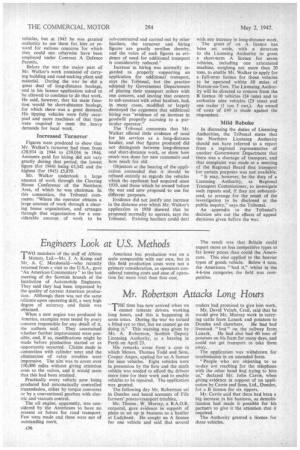Engineers Look at U.S. Methods
Page 46

If you've noticed an error in this article please click here to report it so we can fix it.
r-rWO members of the staff of Albion
Motors, Ltd.—Mr. J. A. Kemp and Mr, A. C. Macdonald—who recently returned from a visit to the U.S.A., gave "An American Commentary" to the last meeting of the Scottish branch of the Institution of Automobile Engineers. They said they had been impressed by the quality of current American production. Although there was not the same reliance upon operating skill, a very high degree of accuracy and finish was obtained.
When a new engine was produced in America, examples were tested by every concern responsible for any detail of it, the authors said. They ascertained whether further improvement were possible, and, if so, modifications might be made before production started or as opportunity occurred. Claims made in connection with cylinder wear and the elimination of valve troubles were impressive. The aim was to cover over 150,000 miles without giving attention even to the valves, and it would seem that this had been attained.
Practically every vehicle now being produced had automatically controlled transmission, either by torque converter or by a conventional gearbox with electric and vacuum control.
The oil engine, apparently, was considered by the Americans to have no present or future for road transport. Few were made and these were not of outstanding merit. American bus' production was on a scale comparable with our own, but in this field production costs were not a primary consideration, as operators considered running costs and ease of operation far more vital than first cost. The result was that Britain could export more or less competitive types at far lower prices than could the Americans. This also applied to the heavier types of goods vehicle. Below 4 tons, the Americans "had it," whilst in the 4-6-ton categories the field was competitive.












































































